Target Information
| Target General Information | Top | |||||
|---|---|---|---|---|---|---|
| Target ID |
T63966
(Former ID: TTDS00007)
|
|||||
| Target Name |
Vascular endothelial growth factor receptor 1 (FLT-1)
|
|||||
| Synonyms |
Vascular permeability factor receptor; VEGFR1; VEGFR-1; VEGF-1 receptor; Tyrosine-protein kinase receptor FLT; Tyrosine-protein kinase FRT; Fms-like tyrosine kinase 1; FRT; FLT
Click to Show/Hide
|
|||||
| Gene Name |
FLT1
|
|||||
| Target Type |
Successful target
|
[1] | ||||
| Disease | [+] 1 Target-related Diseases | + | ||||
| 1 | Renal cell carcinoma [ICD-11: 2C90] | |||||
| Function |
May play an essential role as a negative regulator of embryonic angiogenesis by inhibiting excessive proliferation of endothelial cells. Can promote endothelial cell proliferation, survival and angiogenesis in adulthood. Its function in promoting cell proliferation seems to be cell-type specific. Promotes PGF-mediated proliferation of endothelial cells, proliferation of some types of cancer cells, but does not promote proliferation of normal fibroblasts (in vitro). Has very high affinity for VEGFA and relatively low protein kinase activity; may function as a negative regulator of VEGFA signaling by limiting the amount of free VEGFA and preventing its binding to KDR. Likewise, isoforms lacking a transmembrane domain, such as isoform 2, isoform 3 and isoform 4, may function as decoy receptors for VEGFA. Modulates KDR signaling by forming heterodimers with KDR. Ligand binding leads to the activation of several signaling cascades. Activation of PLCG leads to the production of the cellular signaling molecules diacylglycerol and inositol 1,4,5-trisphosphate and the activation of protein kinase C. Mediates phosphorylation of PIK3R1, the regulatory subunit of phosphatidylinositol 3-kinase, leading to activation of phosphatidylinositol kinase and the downstream signaling pathway. Mediates activation of MAPK1/ERK2, MAPK3/ERK1 and the MAP kinase signaling pathway, as well as of the AKT1 signaling pathway. Phosphorylates SRC and YES1, and may also phosphorylate CBL. Isoform 1 phosphorylates PLCG. Promotes phosphorylation of AKT1 at 'Ser-473'. Promotes phosphorylation of PTK2/FAK1. Isoform 7 has a truncated kinase domain; it increases phosphorylation of SRC at 'Tyr-418' by unknown means and promotes tumor cell invasion. Tyrosine-protein kinase that acts as a cell-surface receptor for VEGFA, VEGFB and PGF, and plays an essential role in the development of embryonic vasculature, the regulation of angiogenesis, cell survival, cell migration, macrophage function, chemotaxis, and cancer cell invasion.
Click to Show/Hide
|
|||||
| BioChemical Class |
Kinase
|
|||||
| UniProt ID | ||||||
| EC Number |
EC 2.7.10.1
|
|||||
| Sequence |
MVSYWDTGVLLCALLSCLLLTGSSSGSKLKDPELSLKGTQHIMQAGQTLHLQCRGEAAHK
WSLPEMVSKESERLSITKSACGRNGKQFCSTLTLNTAQANHTGFYSCKYLAVPTSKKKET ESAIYIFISDTGRPFVEMYSEIPEIIHMTEGRELVIPCRVTSPNITVTLKKFPLDTLIPD GKRIIWDSRKGFIISNATYKEIGLLTCEATVNGHLYKTNYLTHRQTNTIIDVQISTPRPV KLLRGHTLVLNCTATTPLNTRVQMTWSYPDEKNKRASVRRRIDQSNSHANIFYSVLTIDK MQNKDKGLYTCRVRSGPSFKSVNTSVHIYDKAFITVKHRKQQVLETVAGKRSYRLSMKVK AFPSPEVVWLKDGLPATEKSARYLTRGYSLIIKDVTEEDAGNYTILLSIKQSNVFKNLTA TLIVNVKPQIYEKAVSSFPDPALYPLGSRQILTCTAYGIPQPTIKWFWHPCNHNHSEARC DFCSNNEESFILDADSNMGNRIESITQRMAIIEGKNKMASTLVVADSRISGIYICIASNK VGTVGRNISFYITDVPNGFHVNLEKMPTEGEDLKLSCTVNKFLYRDVTWILLRTVNNRTM HYSISKQKMAITKEHSITLNLTIMNVSLQDSGTYACRARNVYTGEEILQKKEITIRDQEA PYLLRNLSDHTVAISSSTTLDCHANGVPEPQITWFKNNHKIQQEPGIILGPGSSTLFIER VTEEDEGVYHCKATNQKGSVESSAYLTVQGTSDKSNLELITLTCTCVAATLFWLLLTLFI RKMKRSSSEIKTDYLSIIMDPDEVPLDEQCERLPYDASKWEFARERLKLGKSLGRGAFGK VVQASAFGIKKSPTCRTVAVKMLKEGATASEYKALMTELKILTHIGHHLNVVNLLGACTK QGGPLMVIVEYCKYGNLSNYLKSKRDLFFLNKDAALHMEPKKEKMEPGLEQGKKPRLDSV TSSESFASSGFQEDKSLSDVEEEEDSDGFYKEPITMEDLISYSFQVARGMEFLSSRKCIH RDLAARNILLSENNVVKICDFGLARDIYKNPDYVRKGDTRLPLKWMAPESIFDKIYSTKS DVWSYGVLLWEIFSLGGSPYPGVQMDEDFCSRLREGMRMRAPEYSTPEIYQIMLDCWHRD PKERPRFAELVEKLGDLLQANVQQDGKDYIPINAILTGNSGFTYSTPAFSEDFFKESISA PKFNSGSSDDVRYVNAFKFMSLERIKTFEELLPNATSMFDDYQGDSSTLLASPMLKRFTW TDSKPKASLKIDLRVTSKSKESGLSDVSRPSFCHSSCGHVSEGKRRFTYDHAELERKIAC CSPPPDYNSVVLYSTPPI Click to Show/Hide
|
|||||
| 3D Structure | Click to Show 3D Structure of This Target | AlphaFold | ||||
| HIT2.0 ID | T84WE9 | |||||
| Drugs and Modes of Action | Top | |||||
|---|---|---|---|---|---|---|
| Clinical Trial Drug(s) | [+] 7 Clinical Trial Drugs | + | ||||
| 1 | E-3810 | Drug Info | Phase 3 | Solid tumour/cancer | [3], [4] | |
| 2 | Sulfatinib | Drug Info | Phase 3 | Neuroendocrine cancer | [5] | |
| 3 | OCV-101 | Drug Info | Phase 2 | Pancreatic cancer | [9] | |
| 4 | X-82 | Drug Info | Phase 2 | Age-related macular degeneration | [10] | |
| 5 | OTSGC-A24 | Drug Info | Phase 1/2 | Colorectal cancer | [11] | |
| 6 | CEP-11981 | Drug Info | Phase 1 | Solid tumour/cancer | [12], [13] | |
| 7 | EW-A-401 | Drug Info | Phase 1 | Peripheral vascular disease | [14] | |
| Discontinued Drug(s) | [+] 2 Discontinued Drugs | + | ||||
| 1 | Angiozyme | Drug Info | Discontinued in Phase 2 | Solid tumour/cancer | [15] | |
| 2 | Telbermin | Drug Info | Discontinued in Phase 2 | Diabetic foot ulcer | [16] | |
| Mode of Action | [+] 3 Modes of Action | + | ||||
| Inhibitor | [+] 4 Inhibitor drugs | + | ||||
| 1 | E-3810 | Drug Info | [17] | |||
| 2 | Sulfatinib | Drug Info | [18] | |||
| 3 | AAL-993 | Drug Info | [24] | |||
| 4 | SU-11652 | Drug Info | [25] | |||
| Modulator | [+] 5 Modulator drugs | + | ||||
| 1 | OCV-101 | Drug Info | [19] | |||
| 2 | X-82 | Drug Info | [20] | |||
| 3 | CEP-11981 | Drug Info | [12] | |||
| 4 | EW-A-401 | Drug Info | [22] | |||
| 5 | Angiozyme | Drug Info | [23] | |||
| Activator | [+] 1 Activator drugs | + | ||||
| 1 | Telbermin | Drug Info | [16] | |||
| Cell-based Target Expression Variations | Top | |||||
|---|---|---|---|---|---|---|
| Cell-based Target Expression Variations | ||||||
| Drug Binding Sites of Target | Top | |||||
|---|---|---|---|---|---|---|
| Ligand Name: AG-E-85378 | Ligand Info | |||||
| Structure Description | Crystal structure of VEGFR1 in complex with N-(4-Chlorophenyl)-2-((pyridin-4-ylmethyl)amino)benzamide | PDB:3HNG | ||||
| Method | X-ray diffraction | Resolution | 2.70 Å | Mutation | No | [26] |
| PDB Sequence |
EVPLDEQCER
812 PYDASKWEFA823 RERLKLGKSL833 GRGAFGKVVQ843 ASAFGIKKSP853 TCRTVAVKML 863 KEGATASEYK873 ALMTELKILT883 HIGHHLNVVN893 LLGACTKQGG903 PLMVIVEYCK 913 YGNLSNYLKS923 KRKEPITMED998 LISYSFQVAR1008 GMEFLSSRKC1018 IHRDLAARNI 1028 LLSENNVVKI1038 CDFGLARDIY1048 KNPDYVRKTR1060 LPLKWMAPES1070 IFDKIYSTKS 1080 DVWSYGVLLW1090 EIFSLGGSPY1100 PGVQMDEDFC1110 SRLREGMRMR1120 APEYSTPEIY 1130 QIMLDCWHRD1140 PKERPRFAEL1150 VEKLGDLL
|
|||||
|
|
LEU833
3.963
VAL841
3.938
ALA859
3.884
VAL860
4.106
LYS861
3.309
GLU878
2.795
LEU882
3.856
ILE885
4.860
VAL891
4.136
VAL892
4.164
VAL907
3.623
VAL909
3.459
|
|||||
| Click to View More Binding Site Information of This Target with Different Ligands | ||||||
| Different Human System Profiles of Target | Top |
|---|---|
|
Human Similarity Proteins
of target is determined by comparing the sequence similarity of all human proteins with the target based on BLAST. The similarity proteins for a target are defined as the proteins with E-value < 0.005 and outside the protein families of the target.
A target that has fewer human similarity proteins outside its family is commonly regarded to possess a greater capacity to avoid undesired interactions and thus increase the possibility of finding successful drugs
(Brief Bioinform, 21: 649-662, 2020).
Human Tissue Distribution
of target is determined from a proteomics study that quantified more than 12,000 genes across 32 normal human tissues. Tissue Specificity (TS) score was used to define the enrichment of target across tissues.
The distribution of targets among different tissues or organs need to be taken into consideration when assessing the target druggability, as it is generally accepted that the wider the target distribution, the greater the concern over potential adverse effects
(Nat Rev Drug Discov, 20: 64-81, 2021).
Human Pathway Affiliation
of target is determined by the life-essential pathways provided on KEGG database. The target-affiliated pathways were defined based on the following two criteria (a) the pathways of the studied target should be life-essential for both healthy individuals and patients, and (b) the studied target should occupy an upstream position in the pathways and therefore had the ability to regulate biological function.
Targets involved in a fewer pathways have greater likelihood to be successfully developed, while those associated with more human pathways increase the chance of undesirable interferences with other human processes
(Pharmacol Rev, 58: 259-279, 2006).
Biological Network Descriptors
of target is determined based on a human protein-protein interactions (PPI) network consisting of 9,309 proteins and 52,713 PPIs, which were with a high confidence score of ≥ 0.95 collected from STRING database.
The network properties of targets based on protein-protein interactions (PPIs) have been widely adopted for the assessment of target’s druggability. Proteins with high node degree tend to have a high impact on network function through multiple interactions, while proteins with high betweenness centrality are regarded to be central for communication in interaction networks and regulate the flow of signaling information
(Front Pharmacol, 9, 1245, 2018;
Curr Opin Struct Biol. 44:134-142, 2017).
Human Similarity Proteins
Human Tissue Distribution
Human Pathway Affiliation
Biological Network Descriptors
|
|
|
Note:
If a protein has TS (tissue specficity) scores at least in one tissue >= 2.5, this protein is called tissue-enriched (including tissue-enriched-but-not-specific and tissue-specific). In the plots, the vertical lines are at thresholds 2.5 and 4.
|
| KEGG Pathway | Pathway ID | Affiliated Target | Pathway Map |
|---|---|---|---|
| MAPK signaling pathway | hsa04010 | Affiliated Target |

|
| Class: Environmental Information Processing => Signal transduction | Pathway Hierarchy | ||
| Ras signaling pathway | hsa04014 | Affiliated Target |
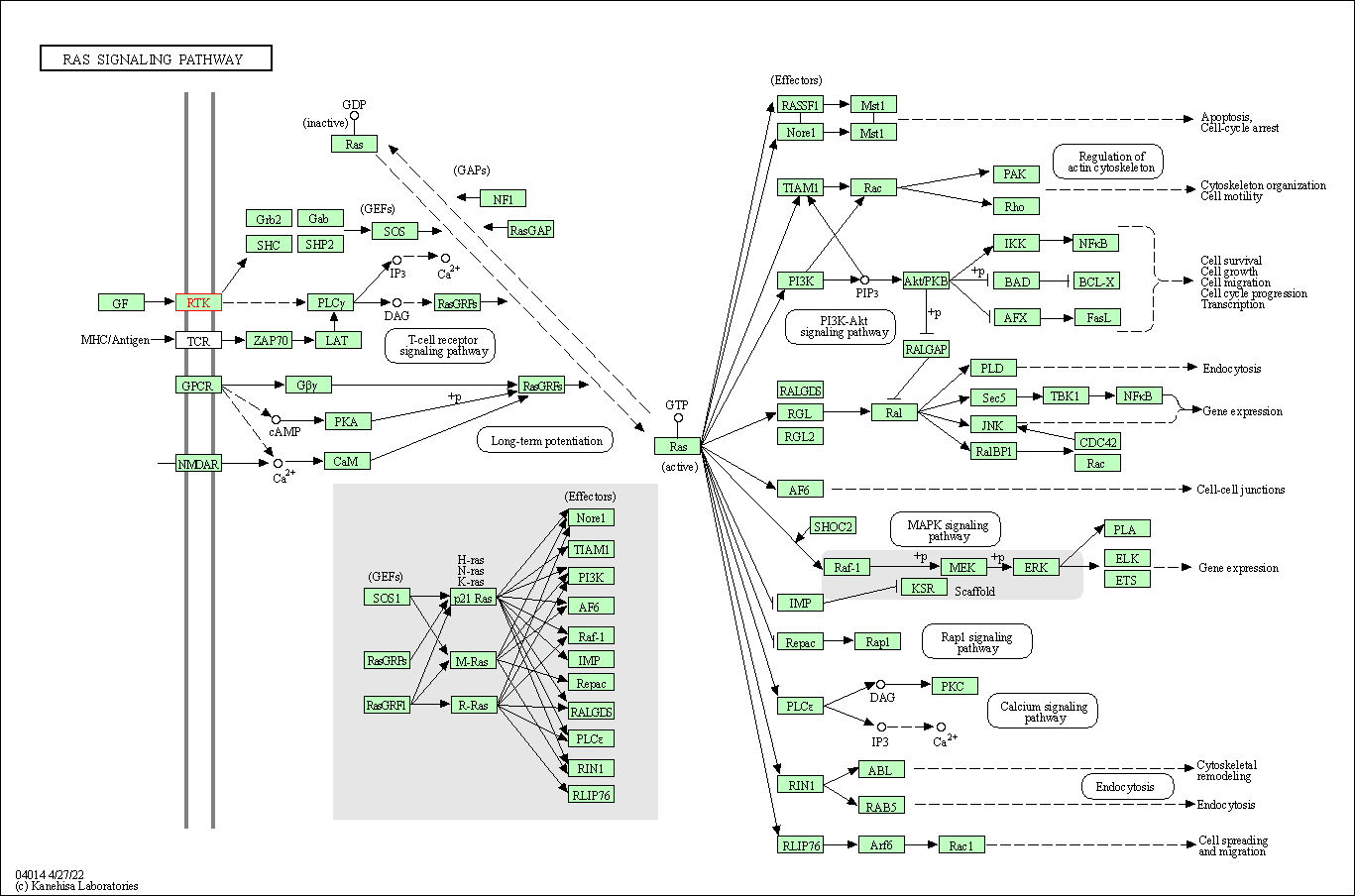
|
| Class: Environmental Information Processing => Signal transduction | Pathway Hierarchy | ||
| Rap1 signaling pathway | hsa04015 | Affiliated Target |
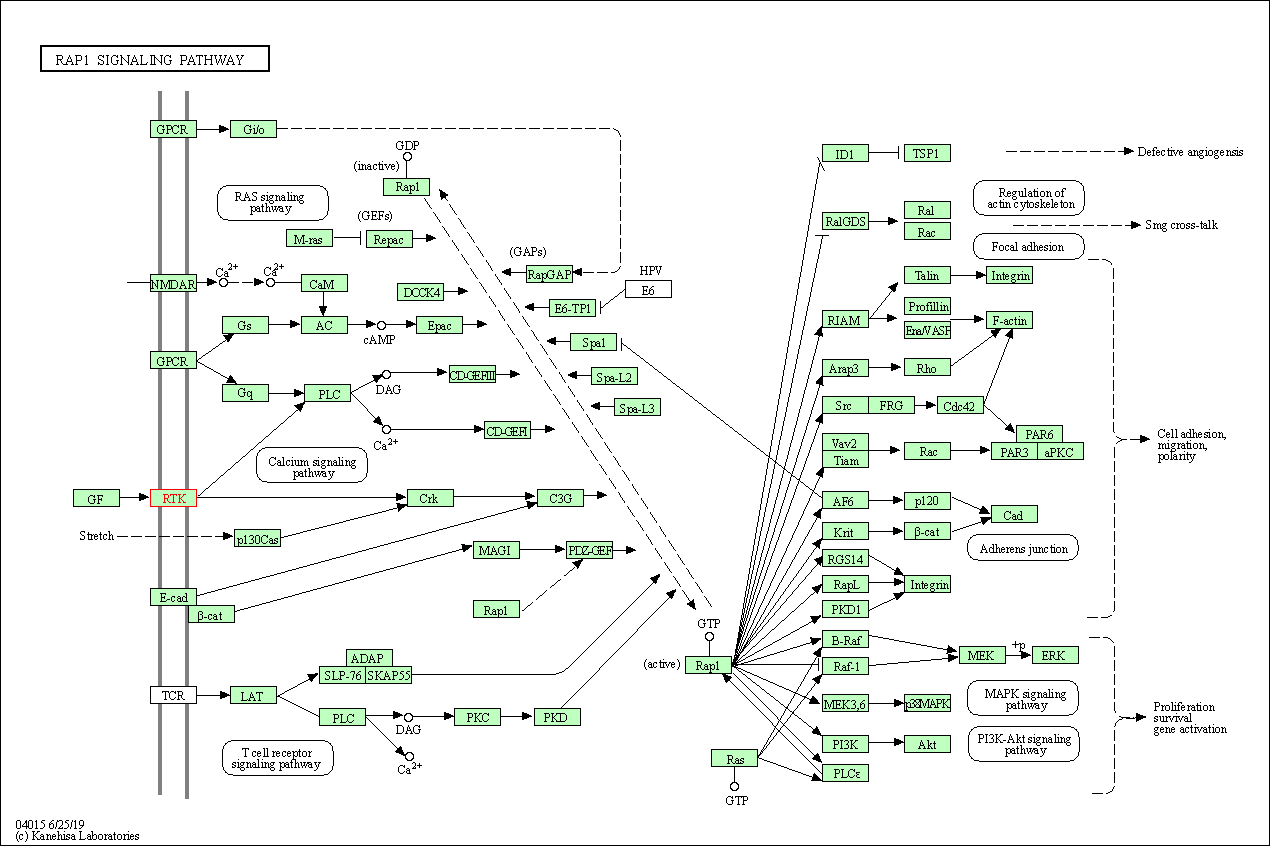
|
| Class: Environmental Information Processing => Signal transduction | Pathway Hierarchy | ||
| Calcium signaling pathway | hsa04020 | Affiliated Target |
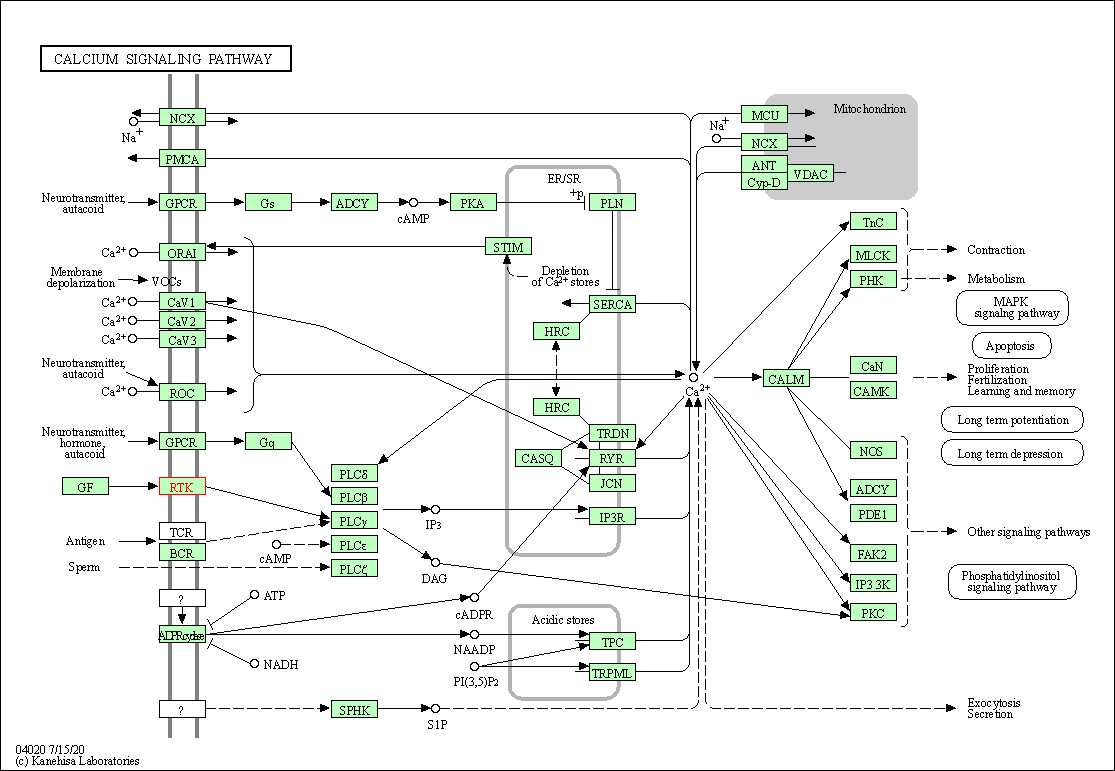
|
| Class: Environmental Information Processing => Signal transduction | Pathway Hierarchy | ||
| HIF-1 signaling pathway | hsa04066 | Affiliated Target |

|
| Class: Environmental Information Processing => Signal transduction | Pathway Hierarchy | ||
| PI3K-Akt signaling pathway | hsa04151 | Affiliated Target |
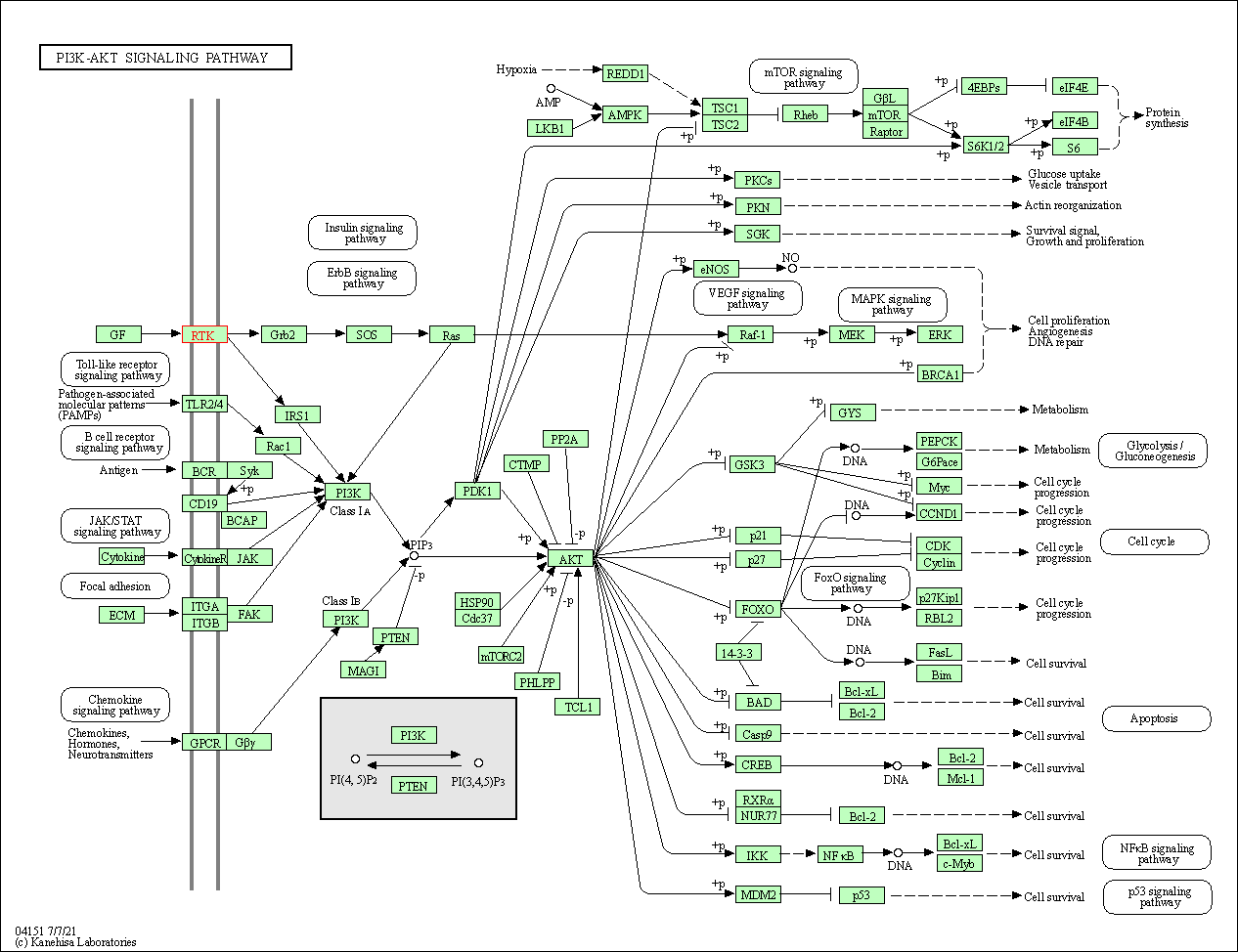
|
| Class: Environmental Information Processing => Signal transduction | Pathway Hierarchy | ||
| Focal adhesion | hsa04510 | Affiliated Target |
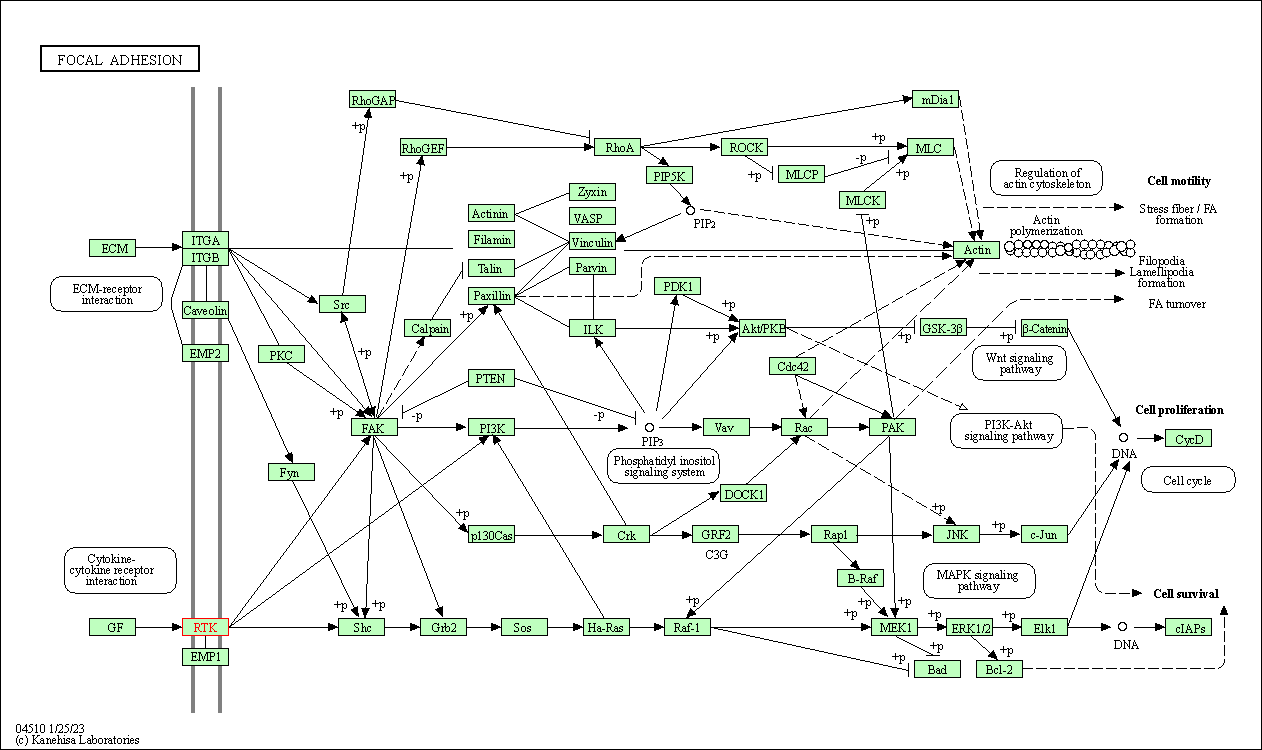
|
| Class: Cellular Processes => Cellular community - eukaryotes | Pathway Hierarchy | ||
| Click to Show/Hide the Information of Affiliated Human Pathways | |||
| Degree | 19 | Degree centrality | 2.04E-03 | Betweenness centrality | 3.00E-04 |
|---|---|---|---|---|---|
| Closeness centrality | 2.34E-01 | Radiality | 1.41E+01 | Clustering coefficient | 3.57E-01 |
| Neighborhood connectivity | 4.46E+01 | Topological coefficient | 1.24E-01 | Eccentricity | 12 |
| Download | Click to Download the Full PPI Network of This Target | ||||
| Chemical Structure based Activity Landscape of Target | Top |
|---|---|
| Drug Property Profile of Target | Top | |
|---|---|---|
| (1) Molecular Weight (mw) based Drug Clustering | (2) Octanol/Water Partition Coefficient (xlogp) based Drug Clustering | |
|
|
||
| (3) Hydrogen Bond Donor Count (hbonddonor) based Drug Clustering | (4) Hydrogen Bond Acceptor Count (hbondacc) based Drug Clustering | |
|
|
||
| (5) Rotatable Bond Count (rotbonds) based Drug Clustering | (6) Topological Polar Surface Area (polararea) based Drug Clustering | |
|
|
||
| "RO5" indicates the cutoff set by lipinski's rule of five; "D123AB" colored in GREEN denotes the no violation of any cutoff in lipinski's rule of five; "D123AB" colored in PURPLE refers to the violation of only one cutoff in lipinski's rule of five; "D123AB" colored in BLACK represents the violation of more than one cutoffs in lipinski's rule of five | ||
| Co-Targets | Top | |||||
|---|---|---|---|---|---|---|
| Co-Targets | ||||||
| Target Poor or Non Binders | Top | |||||
|---|---|---|---|---|---|---|
| Target Poor or Non Binders | ||||||
| Target Regulators | Top | |||||
|---|---|---|---|---|---|---|
| Target-regulating microRNAs | ||||||
| Target-interacting Proteins | ||||||
| Target Profiles in Patients | Top | |||||
|---|---|---|---|---|---|---|
| Target Expression Profile (TEP) | ||||||
| Target Affiliated Biological Pathways | Top | |||||
|---|---|---|---|---|---|---|
| KEGG Pathway | [+] 9 KEGG Pathways | + | ||||
| 1 | Ras signaling pathway | |||||
| 2 | Rap1 signaling pathway | |||||
| 3 | Cytokine-cytokine receptor interaction | |||||
| 4 | HIF-1 signaling pathway | |||||
| 5 | Endocytosis | |||||
| 6 | PI3K-Akt signaling pathway | |||||
| 7 | Focal adhesion | |||||
| 8 | Transcriptional misregulation in cancer | |||||
| 9 | Rheumatoid arthritis | |||||
| PID Pathway | [+] 6 PID Pathways | + | ||||
| 1 | Glypican 1 network | |||||
| 2 | HIF-2-alpha transcription factor network | |||||
| 3 | S1P3 pathway | |||||
| 4 | VEGF and VEGFR signaling network | |||||
| 5 | VEGFR1 specific signals | |||||
| 6 | Signaling events mediated by VEGFR1 and VEGFR2 | |||||
| Reactome | [+] 2 Reactome Pathways | + | ||||
| 1 | Neurophilin interactions with VEGF and VEGFR | |||||
| 2 | VEGF binds to VEGFR leading to receptor dimerization | |||||
| WikiPathways | [+] 3 WikiPathways | + | ||||
| 1 | Focal Adhesion | |||||
| 2 | Signaling by VEGF | |||||
| 3 | Angiogenesis | |||||
| Target-Related Models and Studies | Top | |||||
|---|---|---|---|---|---|---|
| Target Validation | ||||||
| Target QSAR Model | ||||||
| References | Top | |||||
|---|---|---|---|---|---|---|
| REF 1 | Development of ranibizumab, an anti-vascular endothelial growth factor antigen binding fragment, as therapy for neovascular age-related macular degeneration. Retina. 2006 Oct;26(8):859-70. | |||||
| REF 2 | Drugs@FDA. U.S. Food and Drug Administration. U.S. Department of Health Human Services | |||||
| REF 3 | URL: http://www.guidetopharmacology.org Nucleic Acids Res. 2015 Oct 12. pii: gkv1037. The IUPHAR/BPS Guide to PHARMACOLOGY in 2016: towards curated quantitative interactions between 1300 protein targets and 6000 ligands. (Ligand id: 7649). | |||||
| REF 4 | ClinicalTrials.gov (NCT02135107) A Double-blind Comparative Study of the Efficacy and Safety of E3810 10mg Once and Twice Daily in Maintenance Therapy for PPI Resistant Gastroesophageal Reflux Disease Patients. U.S. National Institutes of Health. | |||||
| REF 5 | ClinicalTrials.gov (NCT02589821) Phase III Study of Surufatinib in Treating Advanced Pancreatic Neuroendocrine Tumors. U.S. National Institutes of Health. | |||||
| REF 6 | Trusted, scientifically sound profiles of drug programs, clinical trials, safety reports, and company deals, written by scientists. Springer. 2015. Adis Insight (drug id 800024862) | |||||
| REF 7 | URL: http://www.guidetopharmacology.org Nucleic Acids Res. 2015 Oct 12. pii: gkv1037. The IUPHAR/BPS Guide to PHARMACOLOGY in 2016: towards curated quantitative interactions between 1300 protein targets and 6000 ligands. (Ligand id: 7886). | |||||
| REF 8 | Metabolism and bioactivation of famitinib, a novel inhibitor of receptor tyrosine kinase, in cancer patients. Br J Pharmacol. 2013 Apr;168(7):1687-706. | |||||
| REF 9 | Trusted, scientifically sound profiles of drug programs, clinical trials, safety reports, and company deals, written by scientists. Springer. 2015. Adis Insight (drug id 800031248) | |||||
| REF 10 | ClinicalTrials.gov (NCT02348359) X-82 to Treat Age-related Macular Degeneration. U.S. National Institutes of Health. | |||||
| REF 11 | ClinicalTrials.gov (NCT01227772) Study of OTSGC-A24 Vaccine in Advanced Gastric Cancer. U.S. National Institutes of Health. | |||||
| REF 12 | URL: http://www.guidetopharmacology.org Nucleic Acids Res. 2015 Oct 12. pii: gkv1037. The IUPHAR/BPS Guide to PHARMACOLOGY in 2016: towards curated quantitative interactions between 1300 protein targets and 6000 ligands. (Ligand id: 8189). | |||||
| REF 13 | ClinicalTrials.gov (NCT00875264) Open-Label Study to Determine the Maximum Tolerated Oral Dose of the Kinase Inhibitor CEP-11981 in Patients With Advanced Cancer. U.S. National Institutes of Health. | |||||
| REF 14 | ClinicalTrials.gov (NCT00080392) EW-A-401 to Treat Intermittent Claudication. U.S. National Institutes of Health. | |||||
| REF 15 | Trusted, scientifically sound profiles of drug programs, clinical trials, safety reports, and company deals, written by scientists. Springer. 2015. Adis Insight (drug id 800009459) | |||||
| REF 16 | Emerging drugs for diabetic foot ulcers. Expert Opin Emerg Drugs. 2006 Nov;11(4):709-24. | |||||
| REF 17 | E-3810 is a potent dual inhibitor of VEGFR and FGFR that exerts antitumor activity in multiple preclinical models. Cancer Res. 2011 Feb 15;71(4):1396-405. | |||||
| REF 18 | Clinical pipeline report, company report or official report of Hutchison Medi Pharma. | |||||
| REF 19 | Phase I trial of OTS11101, an anti-angiogenic vaccine targeting vascular endothelial growth factor receptor 1 in solid tumor.Cancer Sci.2013 Jan;104(1):98-104. | |||||
| REF 20 | National Cancer Institute Drug Dictionary (drug id 695817). | |||||
| REF 21 | J Clin Oncol 33, 2015 (suppl 3; abstr 65). | |||||
| REF 22 | DOI: http://dx.doi.org/10.1016/j.tips.2014.09.007 | |||||
| REF 23 | An open-label, phase 2 trial of RPI.4610 (Angiozyme) in the treatment of metastatic breast cancer.Cancer.2012 Sep 1;118(17):4098-104. | |||||
| REF 24 | Anthranilic acid amides: a novel class of antiangiogenic VEGF receptor kinase inhibitors. J Med Chem. 2002 Dec 19;45(26):5687-93. | |||||
| REF 25 | Discovery of 5-[5-fluoro-2-oxo-1,2- dihydroindol-(3Z)-ylidenemethyl]-2,4- dimethyl-1H-pyrrole-3-carboxylic acid (2-diethylaminoethyl)amide, a novel... J Med Chem. 2003 Mar 27;46(7):1116-9. | |||||
| REF 26 | Crystal structure of VEGFR1 in complex with N-(4-Chlorophenyl)-2-((pyridin-4-ylmethyl)amino)benzamide | |||||
If You Find Any Error in Data or Bug in Web Service, Please Kindly Report It to Dr. Zhou and Dr. Zhang.

